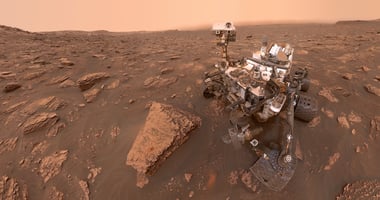Charles Bolden, a former space shuttle commander and National Aeronautics and Space Administration...
The Road to Mars: Potholes or Plain Sailing?
Charles Bolden, a former space shuttle commander and National Aeronautics and Space Administration (NASA) Administrator from 2009 to 2017, dreamed of being the first person on Mars when he checked in for astronaut training in 1980. At the time, NASA thought that a crewed Mars mission was thirty years away. Of course, we know now that prediction was overly optimistic.
Now, recent technological advancements are bringing a renewed interest in human exploration of the Red Planet. In fact, SpaceX just tested its newest ship that, purportedly, can carry as many as 100 “colonists” to Mars. But before we start shopping for spacesuits and MREs that are consumable in microgravity, let’s understand a bit more about the planet, why the U.S. and other countries are interested in colonization, and the challenges posed by such a mission.
About The Red Planet

Our fourth planet’s current name comes from the Roman god of war because of its red, blood-like hue. In fact, all of the planets in our solar system have been given names that are inherited from Greek or Roman gods except Earth (“Earth” is an early Germanic word meaning, “ground”). Ancient Greeks named the planet “Ares” after their war deity, the Chinese called it "the fire star,” and the Egyptians, "Her Desher," which translates to "the red one."
Human beings’ fascination with Mars was born of the “naked-eye” observation, well before the crafted lens. First historical mention of the planet was recorded in ancient Egyptian hieroglyphics. Discovered within the tomb of Pharaoh Seti I, who died around 1279 B.C., was a depiction of the planet. As early as 1045 B.C., Chinese astronomers were recording its movement in the firmament. About 300 years later, Babylonian astronomers, who associated Mars with the war god Negral, began keeping detailed accounts of its planetary movement. Plato included a mention of Mars in The Republic (circa 380 B.C). Galileo Galilei (1564-1642) is believed to have been the first to explore the planet through a telescope, though he could not discern the surface features. It was not until 1659 that Dutch astronomer, Christian Huygens, illustrated the Martian topography.
The modern chronology of Mars’ exploration began in the early 1960s with five failed Soviet probes. The U.S. entered the fray in November of 1964 with Mariner 3. Its solar panels did not open, thus preventing the probe from completing its fly-by. The Mariner 4 did have a successful fly-by in 1965, passing within 6,100 miles of the surface after an eight-month journey.
The nearly two dozen photos from Mariner 4 revealed a cratered surface, a thin atmosphere mostly of carbon dioxide, and a small intrinsic magnetic field. Several other U.S. and Soviet missions through the 1960s to the early 1970s resulted in high-resolution images of the red planets moons, Deimos and Phobos. These missions would discover the river and channel-like features on the surface. U.S. Viking missions were to follow, and became the first to touch down on the planet’s surface successfully. Probes provided detailed color panoramic views of the Martian terrain and planetary weather data. NASA probes were also used to search for micro-organisms. Scientists are still debating the findings from these experiments.
Despite many failed missions along the way, on-going exploration continues to provide more information about the planet’s surface, its atmosphere, dramatic climate changes throughout its history, seismic activity, and geological composition.
Why Mars?
In 2013, Mars One, a Dutch non-profit, invited volunteers to apply for a future one-way trip to the Red Planet. The organization actually received over 200,000 applications despite the obvious personal sacrifices and the certainty of death. Many believe enthusiasm around colonizing the planet is rooted in worry about the unpredictable fate of Earth.
Mariner missions sent back photographic evidence of geological and topographical variations similar, in many respects to our planets volcanoes, sand dunes, canyons, snowy polar caps, and dry riverbeds. Perhaps these similarities to Earth, and other likenesses such as a 24.6-hour day, proximity to sun, availability of water, the prospects for generating food, oxygen, and building materials on-site contribute to the argument of colonization. There’s even the long-term possibility of terraforming the planet to provide a habitable environment, which could sustain human life.
Certainly the the world’s space agencies agree that a crewed mission to colonize the Red Planet is the “horizon goal” for human spaceflight. It is interesting to note that, in response to the naysayers who believe this is not attainable, an MIT research group published a widely read report debunking critics’ arguments. Many science “fiction” writers seem to have accepted the possibility, too. Author, Matt Williams, provides an intriguing summary of books about colonizing the Red Planet from the 1950s to the present.
To Be or Not to Be?
So, after four dozen or so unmanned missions, two-thirds of them failing, how close are we really to landing humans on Mars? In 2010, President Obama called for a manned mission sometime in the 2030s. While President Trump later signed the funding bill for the mission, he expressed dissatisfaction with the timeline. Instead, he wants the mission to occur before the end of his second term in office (2025), if re-elected. Other serious enthusiasts like Elon Musk of SpaceX have not only embraced the vision of humans on Mars, but expanded it to include plans for human colonization.
According to NASA, the main impediment to such a mission is that “getting to Mars is hard.” The spaceship will need to fly through 300 million miles of deep space that includes “road hazards” like solar flares that can damage electronics and energy particles that can pass through a chip in the spacecraft’s computer possibly corrupting data. Moreover, the destination is a very precise spot where even a small trajectory error can result in a big detour or a complete miss. And then, there is the challenge of entry, descent, and landing – that is, getting a massive spacecraft traveling at 12,000 miles per hour slowed down in the six-minute time frame to have a chance of survival. Nonetheless, NASA believes that a manned launch to Mars is clear, affordable, and sustainable. This super exploration, however, will require advanced technical and specialist equipment.
Artificial Intelligence
One of the critical technologies is artificial intelligence (AI). AI systems can take into account variables and circumstances to provide locating any inconsistencies faster and more accurately than people – especially when the human user is in a stressful situation. As an example of the value-add of AI, Steven Smith, AI researcher at Carnegie Mellon University, noted that if NASA had used AI in the planning of the latest Jupiter fly-by, much of the 300,000 human hours of planning for the two-week window for taking photos and making other observations could have been redirected to other projects.
In the application of AI that NASA has envisioned, a human has input for scheduling and problem-solving, while the AI component would do the “heavy lifting” as an “amplifier” of decision-making. It is likely that the major AI system would be ground-based, rather than embedded in the spacecraft’s software as a means to keep launch weight feasible. Improving in flight calculations such as trajectory, through AI could allow scientists to send commands and determine flight rule variations with less effort.
Recycling and Sustainability
Improvements in recycling and sustainability technology must address the astronauts’ need to “live off the land” and to recycle material in a closed system. This would include the consumption of recycled urine and growing food with less sunlight than the inner solar system. While the International Space Station (ISS) has provided a good test case for recycling, the ISS must be resupplied via spacecraft several times each year. Considering the distance to Mars, supply missions would be expensive and somewhat impractical.
Sensors
NASA must conduct further testing and development of sensors that detect conditions inside the crew’s cabin, too. Returning to earth spacecraft will pass through high radiation exposure and temperatures of 4,000 degrees Fahrenheit. Upon descent craft can reach re-entry speeds of up to 20,000 miles per hour, fully-functioning sensors are mission critical.
Solar Radiation
Reducing exposure to radiation during the trip to and from Mars is a significant challenge for engineers and physicists. Earth’s atmosphere provides a natural barrier that protects us from cosmic rays. Astronauts in low Earth orbit are shielded somewhat from radiation by Earth’s naturally occurring magnetic field enveloping our planet, called the magnetosphere (this is the same magnetosphere that interacts with solar weather and provides earth people with the phenomenon Arora Borealis). In contrast, astronauts on an interplanetary voyage will be outside the region of magnetic protection layers of either Mars or Earth. Apollo astronauts reported periodic flashes of light in their vision due to the interaction of cosmic rays with their eyeball fluid.
Any crewed journey to Mars with current technology would unfortunately result in the retirement of these astronaut’s from duty, due to over exposure to radiation that would exceed maximum lifetime limit for people. Some experts have recommended sending astronauts of an older demographic, in their 40s or 50s who may already have children is an appropriate consideration, since crew members would likely succumb to natural causes before experiencing the effects of radiation exposure.
Gravity
Gravity on Mars is about 40% of Earth’s, which would make acclimatizing to the force quite difficult. Permanent settlers would have to contend with the problems of muscle degeneration and osteoporosis over time.
So, how close are we to going to Mars?
Despite these challenges, NASA, SpaceX, Mars One and other organizations remain optimistic and continue to work toward the goal of colonization.
Perhaps after generations of terraforming, a Martian colony could be viable. Its economy could be based on real estate initially (when the travel difficulties are overcome) and eventually on the sale of mineral deposits and precious metals. Using organisms like cyanobacteria and phytoplankton, colonists could gradually convert much of the CO² in the atmosphere into breathable oxygen.
A significant amount of carbon dioxide in dry ice at the planet’s south pole, if melted, could increase atmospheric pressure to eliminate the need for pressure suits. Some scientists speculate that a melt-down could be triggered deliberately by introducing hydrocarbons and other greenhouse gases into the atmosphere to trigger planetary warming.
Other proposed solutions to the challenges of colonization include orbital mirrors that would heat the surface and deliberately impacting the surface with comets to make the Mars environment more suitable for humans. Yet another is building habitats underground with a series of tunnels that connecting the subterranean habitats.
Clearly, we have made remarkable strides toward colonizing Mars. With continued interest, financial backing, and creativity, we will reach that goal.



